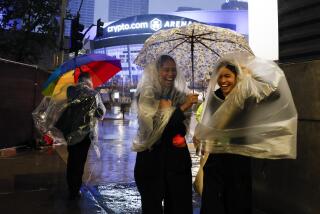Northern Storm Has Little for L.A.
Northern California was battered Tuesday by a powerful winter storm that dumped up to seven feet of snow in the Sierra Nevada, but the weather system had petered out considerably by the time it hit Southern California and it dropped less than a half inch of rain on parched Los Angeles.
The heavy snow was good news in the Sierra, where the snow of winter helps quench the state’s thirst during dry summer months.
After the seventh-driest December on record--and a January that also had been unusually dry--the storm was particularly important for the snowpack.
“Compared to what we’ve had so far this winter, this has been something,” said Gary Barbato, a hydrologist with the National Weather Service in Reno. “It’s really helped the snowpack, which is where our water supply comes from.”
Although the rain did not do much to alleviate Southern California’s prolonged dry spell, it created slick conditions and poor visibility that contributed to a rash of traffic accidents that killed one motorist and injured at least a dozen others.
The California Highway Patrol reported a 150% increase in traffic accidents over a normal morning commute. There were 160 accidents reported in Los Angeles County, compared with an average of 62 on a dry day, the CHP said.
Early Tuesday, Ralph Rivers, 56, of Northridge, was pronounced dead after his car slammed into a trailer that had separated from a jackknifed big rig in the eastbound lanes of the Foothill Freeway in Lake View Terrace, said CHP Officer Shirley Gaines.
The roof and the right side of the coupe were sheared off when the car went under the trailer. The damaged car continued down the freeway, drifted to the right and skidded to a stop at the bottom of an embankment, Gaines said.
A short distance from that accident, a Brinks truck hit a jackknifed big rig, injuring three people in the armored car, one of the them critically, said Los Angeles City Fire Department spokesman Brian Humphrey.
The CHP said traffic collisions closed the connector road from the southbound Foothill Freeway to the eastbound lanes of the roadway for nearly five hours.
Along Interstate 10 in Beaumont, about 25 vehicles, including two big rigs, crashed. And in Cabazon, a trucker lost control of his rig, which overturned on the slick highway.
Although the rainfall was not heavy, the roads were treacherous, said CHP Officer Lou Aviles. Drivers, he said, should slow down and take extra precautions during rainy weather.
“They need to allow for extra time, reduce speed, increase distances, avoid abrupt lane changes and use signals,” Aviles said.
The storm was expected to be over by this morning.
“It’ll be going straight east,” said Amy Talmage, a meteorologist for WeatherData Inc., which provides forecasts for The Times. “Then it’s going to be dry and relatively warm for the next week . . . basically continuing the weather pattern that we’ve had this winter. There are no big storms on the horizon.”
Less than an inch and a half of rain has fallen on downtown Los Angeles since July 1, about one-seventh of the normal season’s total for the date of about 7.4 inches.
Weather experts attributed the second consecutive dry winter to a persistent La Nina oceanic and meteorological condition. But La Nina has the opposite effect in the Northwest, bringing more rainfall than unusual.
In Northern California, the winter has not been as arid as the Southland’s. As of Tuesday, the average water content and precipitation levels in the Truckee River and Tahoe basins were 80% to 90% of normal.
It was not until Jan. 17 that the first significant winter storm pelted the Sierra, bringing snow accumulations of a few inches to two feet. In the past week, however, the snow has been piling up.
Kirkwood ski resort south of Lake Tahoe reported picking up 10 feet of snow in 10 days. At Boreal near Donner Summit off Interstate 80, more than seven feet has fallen since Sunday.
But it is too early to tell whether the Sierra will register a sixth consecutive extra snowy winter, unprecedented in recent memory.
Heavy snow usually falls in February and March, but if no more snow falls for the rest of the season, “We’d end up with a water year of about 40% to 50% of average,” Barbato said. “We have to wait and see what this one will do.”
Associated Press contributed to this story.
More to Read
Sign up for Essential California
The most important California stories and recommendations in your inbox every morning.
You may occasionally receive promotional content from the Los Angeles Times.










